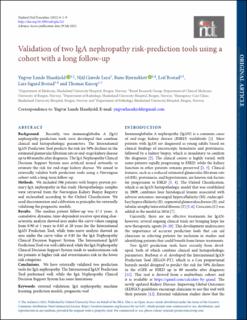| dc.contributor.author | Haaskjold, Yngvar Lunde | |
| dc.contributor.author | Lura, Njål Gjærde | |
| dc.contributor.author | Bjørneklett, Rune Oskar | |
| dc.contributor.author | Bostad, Leif | |
| dc.contributor.author | Bostad, Lars Sigurd | |
| dc.contributor.author | Knoop, Thomas | |
| dc.date.accessioned | 2022-11-10T08:53:52Z | |
| dc.date.available | 2022-11-10T08:53:52Z | |
| dc.date.created | 2022-10-27T09:52:34Z | |
| dc.date.issued | 2022 | |
| dc.identifier.issn | 0931-0509 | |
| dc.identifier.uri | https://hdl.handle.net/11250/3031070 | |
| dc.description.abstract | Background: Recently, two immunoglobulin A (IgA) nephropathy-prediction tools were developed that combine clinical and histopathologic parameters. The International IgAN Prediction Tool predicts the risk for 50% declines in the estimated glomerular filtration rate or end-stage kidney disease up to 80 months after diagnosis. The IgA Nephropathy Clinical Decision Support System uses artificial neural networks to estimate the risk for end-stage kidney disease. We aimed to externally validate both prediction tools using a Norwegian cohort with a long-term follow-up.
Methods: We included 306 patients with biopsy-proven primary IgA nephropathy in this study. Histopathologic samples were retrieved from the Norwegian Kidney Biopsy Registry and reclassified according to the Oxford Classification. We used discrimination and calibration as principles for externally validating the prognostic models.
Results: The median patient follow-up was 17.1 years. A cumulative, dynamic, time-dependent receiver operating characteristic analysis showed area under the curve values ranging from 0.90 at 5 years to 0.83 at 20 years for the International IgAN Prediction Tool, while time-naive analysis showed an area under the curve value at 0.83 for the IgA Nephropathy Clinical Decision Support System. The International IgAN Prediction Tool was well calibrated, while the IgA Nephropathy Clinical Decision Support System tends to underestimate risk for patients at higher risk and overestimates risk in the lower risk categories.
Conclusions: We have externally validated two prediction tools for IgA nephropathy. The International IgAN Prediction Tool performed well, while the IgA Nephropathy Clinical Decision Support System has some limitations. | en_US |
| dc.language.iso | eng | en_US |
| dc.publisher | Oxford University Press | en_US |
| dc.rights | Navngivelse-Ikkekommersiell 4.0 Internasjonal | * |
| dc.rights.uri | http://creativecommons.org/licenses/by-nc/4.0/deed.no | * |
| dc.title | Validation of two IgA nephropathy risk-prediction tools using a cohort with a long follow-up | en_US |
| dc.type | Journal article | en_US |
| dc.type | Peer reviewed | en_US |
| dc.description.version | publishedVersion | en_US |
| dc.rights.holder | Copyright 2022 the authors | en_US |
| dc.source.articlenumber | gfac225 | en_US |
| cristin.ispublished | true | |
| cristin.fulltext | original | |
| cristin.qualitycode | 1 | |
| dc.identifier.doi | 10.1093/ndt/gfac225 | |
| dc.identifier.cristin | 2065496 | |
| dc.source.journal | Nephrology, Dialysis and Transplantation | en_US |
| dc.identifier.citation | Nephrology, Dialysis and Transplantation. 2022. | en_US |

